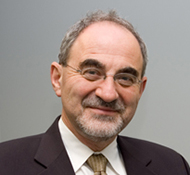Eli Yablonovitch
| Eli Yablonovitch | |
|---|---|
 |
|
| Born |
15 December 1946 Puch bei Hallein, Austria |
| Fields | Physics, Electrical Engineering |
| Institutions | |
| Alma mater | |
| Doctoral advisor | Nicolaas Bloembergen |
| Known for | |
Eli Yablonovitch (born 15 December 1946) is an American physicist and engineer who, along with Sajeev John founded the field of photonic crystals in 1987. He and his team were the first to create a 3-dimensional structure that exhibited a full photonic bandgap, which has been named Yablonovite. In addition to pioneering photonic crystals, he was the first to recognize that a strained quantum-well laser has a significantly reduced threshold current compared to its unstrained counterpart. This is now employed in the majority of semiconductor lasers fabricated throughout the world.
Yablonovitch received his B.Sc. in physics from McGill University in 1967. He went on to receive his A.M. degree in applied physics from Harvard University in 1969, and his Ph.D. from Harvard in 1972. During his post-graduate studies, Yablonovitch worked on nonlinear optics with carbon dioxide lasers.
After receiving his Ph.D., Yablonovitch worked at Bell Laboratories. He then became a professor of applied physics at Harvard in 1974. In 1979, he joined Exxon research center to work on photovoltaic research for solar energy. While working at Exxon, Yablonovitch derived the 4 (n squared) factor as the theoretical limit for light trapping in photovoltaics. This is now used worldwide in almost all solar panels.
Yablonovitch joined Bell Communications Research in 1984, and became its director of solid-state physics research in 1991. During his time at Bell Communications, Yablonovitch did his pioneering work on photonic crystals.
...
Wikipedia
